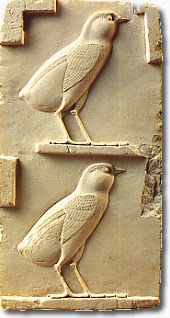1:- The Ancient World
Alphabet at that time and how it influenced today's alphabet
Many believe that the very start of the alphabet can be traced back to ancient egypt. The very first alphabet emerged around 2000 B.C. in ancient Egypt but by this point the basic alphabetical principles has already been included into Egyptian Hieroglyphs for a millenium.
The majority of other alphabets in the world today either descend from this single discovery or were inspired by its design including the phoenician alphabet and the Greek alphabet.
"The rosetta stone shows the coexistence of hieroglyphs, hieratic script and the Greek alphabet in Egypt in the third century B.C."
The invention of written script in ancient Egypt
Ancient Egyptians believed it was vital to record and communicate information about religion and also the government. This would eventually lead to Egyptians inventing a written script to record this important information.
The most famous of these scripts is hieroglyphs. This is the one that the majority of people today would know.
However over the course of the 3000 years of Egyptian history the did create 3 other scripts. Each having their own purpose.
The 4 different types of script were used for things like preserving their beliefs, history and the idea of ancient egypt itself. The forms of script could be recorded on tomb walls, temple walls and papyrus scrolls.
Nicely sculpted hieroglyphic signs on a piece of stone at the Louvre museum, Paris.
Scribes
Who were the scribes
Scribes were usually men who had learned to read and write. To have the right to do both of those things. To become a scribe you had to attend a school purposely built to teach younger people to read and write in hieroglyphs and hieratic scripts. It was said to be very complicated to learn and it came with a massive work load.
It would take 4-5 years to qualify as a scribe and to become a scribe you must be the child of a man who is already a scribe themselves or from a very wealthy family.
A drawing of an interpretation of boys who were attending scribe school.
What writing was used for in ancient Egypt
Rituals
In Egyptian religious beliefs certain rituals had to take place, this was necessary to keep the gods happy. These rituals would be carved into walls and also would be handwritten in papyrus scrolls.
In government
In order to know how ancient Egypt was running and if it was running efficiently, the government officials kept records. This is useful to us now as it gives us a better understanding of how ancient Egypt was run.
The government officials were in fact also scribes, they had been promoted to a higher position. One scribe after being promoted to be a part of the government was the promoted higher and became a Pharaoh.
In the army
Military leaders were trained scribes also. This was necessary for the military leaders as it made them able to communicate whilst at battle.
In the Tombs
One of the most famous examples of written script from ancient Egypt that the majority of people today know if is carved text in tomb walls.
Ancient Egyptians built every Pharaoh their own tomb. The point of each Pharaoh having their own tomb was down to religious beliefs.
Firstly in order for the pharaohs to be taken to the gods in heaven once they die, they needed a place to keep their body and also their belongings until they were taken to the afterlife.
Writing was also a vital part of the burial process also. Not only is the text beautiful artwork for the tombs decoration but it is also a ritual spell to help them get to the afterlife.
Scribes write the script on the walls of the tombs and then the craftsman would carve the script out of stone. The spells are so vital to the burial ritual that once the craftsman has finished carving the script the scribe will check the work he has done and if it is not absolutely perfect they believed the spell would not work thus not helping their Pharaoh reach the afterlife.
The book of the dead
The book of the dead is also a vital part of the burial process. Despite it's name the book of the dead is actually not a book but just a name given to a collection of different spells that were written down. The majority of these spells are directly linked to helping the dead reach the afterlife.
Most of the spells are found are written on papyrus and some on tomb walls. Altogether there are 200 found in total.
Examples of spells written on Papyrus from the book of the dead
"A representation of the Devourer, who waited to eat the hearts of sinners in the afterlife's Hall of Judgment. Papyrus of Ani, c. 1275 BC"
"A depiction of the Opening of the Mouth ritual, in which a mummy is symbolically brought to life. Papyrus of Hunefer, c. 1280 BC."
A good documentary to watch regarding the burial rituals of the Ancient Egyptians is 'Mummifying Alan: Egypt's last secret, which i will add a link for below.





























.jpe)


.jpeg)


